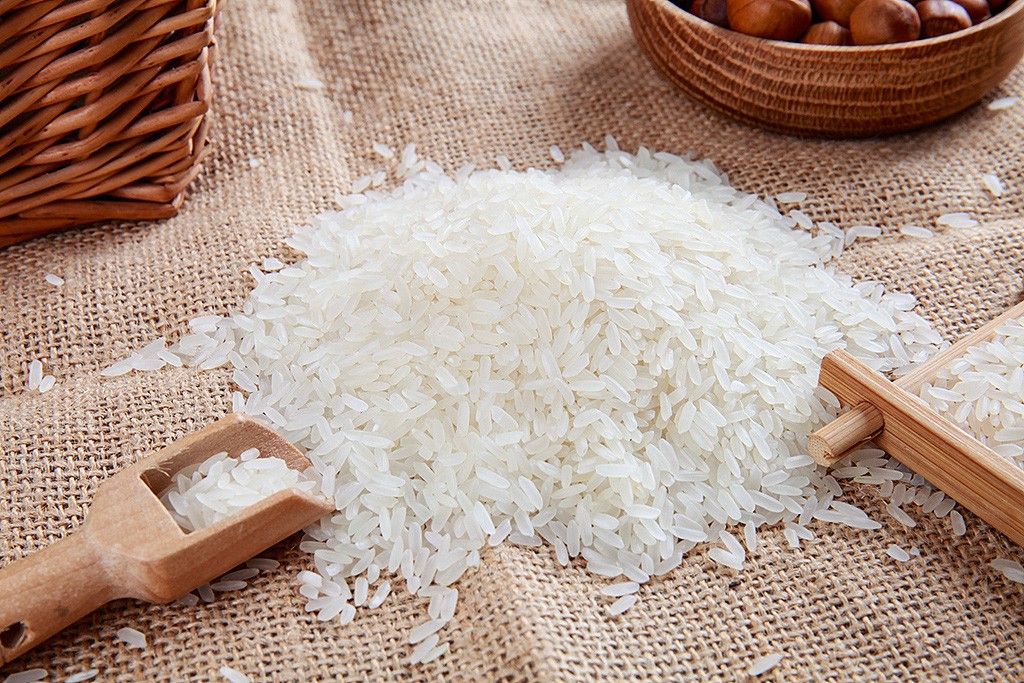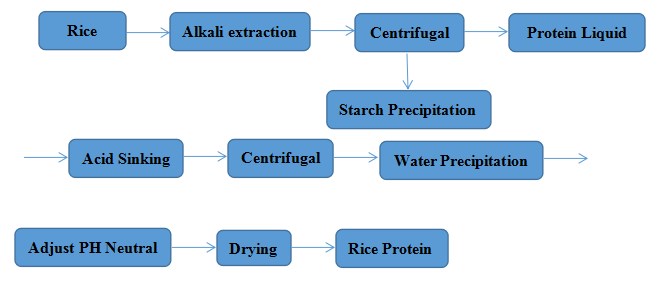Extraction Method Of Rice Protein
2024-01-30 14:09:00
 Agriculture is the basis of the national economy, food is the basis of the foundation, is the human survival, reproduction and development of the necessary conditions, but also the basis of the food industry, is the source of all the basic raw materials of the food industry. Rice (Oyaza sativa) is one of the most important food species, especially in Asia. In 2007, statistics from the International Rice Research Institute showed that in recent years, the total annual production of rice in the world was about 533 million tons, and China's total rice production reached 186.5 million tons, accounting for 35%, ranking first in the world. Rice production and consumption are concentrated in Asia, especially in China, Indonesia, Bangladesh, Vietnam and Thailand. As the country with the largest output of rice in the world, while the rice planting industry is booming, the deep processing and comprehensive utilization of rice provide a new growth point for China's agricultural economy.
Agriculture is the basis of the national economy, food is the basis of the foundation, is the human survival, reproduction and development of the necessary conditions, but also the basis of the food industry, is the source of all the basic raw materials of the food industry. Rice (Oyaza sativa) is one of the most important food species, especially in Asia. In 2007, statistics from the International Rice Research Institute showed that in recent years, the total annual production of rice in the world was about 533 million tons, and China's total rice production reached 186.5 million tons, accounting for 35%, ranking first in the world. Rice production and consumption are concentrated in Asia, especially in China, Indonesia, Bangladesh, Vietnam and Thailand. As the country with the largest output of rice in the world, while the rice planting industry is booming, the deep processing and comprehensive utilization of rice provide a new growth point for China's agricultural economy.
In the process of rice, only starch is usually used, and a large amount of high-quality rice protein in the by-products of rice processing, such as broken rice, rice embryo, rice bran and rice husk, cannot be effectively exploited and utilized, resulting in a great waste of protein resources. The quality of rice protein is superior to wheat protein and corn protein, and it is hypoallergenic. At the same time, the amino acid composition pattern of rice protein is superior to casein protein and soybean protein isolate, and it can meet the amino acid demand of 2-5 years old children, which makes it very suitable for the development of infant food. In addition, rice protein can be processed into soy sauce, high protein powder, protein drinks, peptone and protein foam powder, if it is degraded into short peptide or amino acid, can be made into high nutritional value of amino acid nutrient solution, thus used in health drinks, condiments, food additives, etc.. For a long time, rice production and deep processing of rice processing products and by-products have attracted great attention of food scientists. The development and utilization of rice protein is based on the research and comprehensive utilization of rice processing products and reasonable utilization of rice processing by-products. Therefore, the extraction and rational utilization of rice protein has important social and economic significance.
At present, the raw materials used to produce rice protein are extensive, mostly from the production of starch sugar, monosodium glutamate, organic acids and rice wine by-products, such as broken rice, rice residue, rice bran, etc., with considerable protein content. There are generally two kinds of commercial rice protein: rice protein isolate (RPI) with protein content of more than 90% and rice protein concentrate (RPC) with protein content of 50%~89%. From the current research progress at home and abroad, alkali extraction, solvent extraction, enzymatic extraction, compound extraction and physical separation extraction are common extraction methods of rice protein.
1. The alkaline
Alkali distillation from rice protein contains more than 80% of the alkali soluble glutelin, dilute alkali tight and loose endosperm internal crosslinking structure, subordinated bond, especially hydrogen bond, dissociative some polar groups, to make the protein molecules with the same charge, after solid-liquid separation, dissolution in the protein from the starch granules, add acid to protein isoelectric point coagulation, After the second solid-liquid separation, rice protein with a protein content of more than 85% can be obtained. The technological process is as follows:

2. The solvent
The solvents for extracting rice protein include surfactants, fatty acid salts, weak acids, hydrogen bond breaking agents and reducing agents. Borght extracted proteins with different molecular weights from the endosperm of defatted rice with different solvents. Under experimental conditions, 64% protein could be extracted by 2.0% SDS. Adding 6.0 mol/L urea could make the extraction rate up to 79%. 70% ~ 81% protein could be extracted from 20~100 mmol/L naOH. The maximum extraction rate was obtained by adding 2.0% SDS, 6.0 mol/L urea and 0.5%~1.5% dithiothreitol into the system. Using this kind of non-alkaline solvent to extract rice protein has certain advantages, but the extraction solvent is not easy to remove, the application of the product, especially in the food application, there are safety problems, high extraction solvent cost increases production cost.
3. Enzymatic
Enzymatic extraction can extract more alcohol-soluble and water-soluble proteins, and the water-soluble small active peptides and free amino acids that have been degraded and modified can be divided into protease and non-protease methods. The principle of protease method is that rice protein is degraded and modified by enzyme into soluble peptide and extracted. Rice residue was treated with trypsin and the recovery of rice protein was about 50%. Using alkaline protease, the extraction rate of protein was 63.4% under the following conditions: the initial concentration of raw material without physical treatment was 100 g/L, pH 10.5, E: S 1:10 and temperature 50 ℃. Rice bran protein was extracted with alkaline protease and the extraction rate was 92%. In general, proteins can be extracted by any protease. It was found that Flavourzyme, Neautrase, Alcalse and papain could be used to extract 80%~90% rice protein, and the extraction rate was about 80%, but alkaline protease was the best.
The process of extracting rice protein by protease is usually as follows:
Rice→Add water to adjust the slurry→Enzymolysis→Deenzymetic→Centrifugal Separation→Hydrolysate Drying→Rice Protein
The process of amylase extraction of rice protein is usually as follows :
Rice→Add water to adjust the slurry→Enzymolysis→Deenzymetic→Centrifugal Separation→Sedimentation is dry→Rice Protein
Non-protease method is the use of the concept of impurity elimination, that is, the use of such as starch liquefaction enzyme, cellulase, lipase and other non-protein material in the raw material to remove the retention of protein, so as to improve the protein content of the finished product. Amylase, as a commonly used enzyme preparation in rice protein extraction, can degrade rice starch into dextrin and oligosaccharide, which are more soluble, and then remove them by centrifugation or filtration to improve the protein content in the precipitate.
4. Composite Method
Aiming at the deficiency of rice protein preparation by enzymatic and alkali methods, combining the advantages of the two methods, using protease and alkali solution step by step compound extraction can improve the extraction efficiency. The rice bran protein content was 81.3%, and the color and taste of rice bran protein were better. The complex extraction method is superior to the single extraction method. The complex extraction method has high extraction rate, purity and nutritional value, but the extraction process is complex and the energy consumption is high.
5. Physical Method
Acoustic wave, freeze-thaw, high pressure and high speed homogenization assisted enzymatic extraction of protein from rice bran can achieve ideal results. It was found that rice protein with recovery of 81.87% could be obtained by microfluidic assisted method. Under the sub-critical water condition of 200 ℃ and 30 min, rice protein and amino acid were extracted from defatted rice bran, and the protein yield was higher than that of traditional alkaline hydrolysis. The increasing temperature in the subcriticalwater hydrolysis process leads to an increase in the ionization constant, which leads to the breaking of peptide bonds into soluble small molecules of proteins and amino acids. Physical extraction of protein has high nutritional value, but the extraction rate is lower than other methods.
6. New Extraction Method
Foreign studies have found that the combination of acoustic wave, freeze-thaw, high pressure and high speed homogenization and enzyme treatment has a better effect on protein extraction from rice bran. Rice protein was extracted by ultra-high pressure assisted enzyme method. Single factor and response surface analysis were used to optimize the extraction conditions of rice protein by alkaline protease, and finally the extraction conditions of alkaline protease were determined as follows: Under these conditions, the extraction yield of rice protein was 70%, the enzymolysis temperature was 58℃, the enzymolysis pH was 8.3, the enzymolysis time was 4h and the ratio of liquid to solid was 9∶1. On this basis, the effects of ultra-high pressure on the protein extraction rate of rice were studied. The results showed that under the pressure of 400MPa, the protein extraction rate increased to 78.2%. The research results of extracting rice protein and amino acid from defatted rice bran by subcriticalwater hydrolysis showed that: Under the condition of subcritical water at 200℃ and 30min, rice protein and amino acid can be extracted from defatted rice bran by subcritical water, and the yield of protein is higher than that of traditional alkaline hydrolysis. At the same time, the protein extraction rate increased with the increase of temperature, because the solubility of protein increased at high temperature. However, the main reason is that the ionization constant increases due to the temperature rise, and the peptide bond breaks to form small soluble proteins and amino acids in the presence of hydrated ions and hydroxyl ions.
If you would like to learn more, please contact sales@sxytorganic.com
_1737093401309.png)
